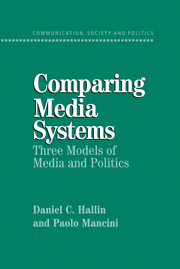Book contents
- Frontmatter
- Contents
- List of Figures and Tables
- List of Acronyms
- Preface
- 1 Introduction
- Part I Concepts and Models
- Part II The Three Models
- 5 The Mediterranean or Polarized Pluralist Model
- 6 The North/Central European or Democratic Corporatist Model
- 7 The North Atlantic or Liberal Model
- Part III The Future of the Three Models
- Bibliography
- Index
7 - The North Atlantic or Liberal Model
Published online by Cambridge University Press: 05 September 2012
- Frontmatter
- Contents
- List of Figures and Tables
- List of Acronyms
- Preface
- 1 Introduction
- Part I Concepts and Models
- Part II The Three Models
- 5 The Mediterranean or Polarized Pluralist Model
- 6 The North/Central European or Democratic Corporatist Model
- 7 The North Atlantic or Liberal Model
- Part III The Future of the Three Models
- Bibliography
- Index
Summary
The Liberal or as it is often called the Anglo-American model of the mass media is in some sense the only model that has really been analyzed in media studies as such, as a coherent model. Indeed, while other media systems have rarely been conceptualized as coherent wholes, it could be said that the “Anglo-American” model has been treated as far more coherent and unitary than it actually is. There are in fact substantial differences between the United States – which is a purer example of a liberal system – and Britain, where statist conservatism, liberal corporatism, and social democracy have been stronger than in the United States. Canada and Ireland, the other two examples of liberal media systems that will be discussed here – are also quite distinct in certain ways. In both countries, for example, issues of national identity result in substantial modifications of the Liberal Model. All of these countries, moreover, have substantial internal differences. This is probably most obvious in the case of Britain, with its sharp distinction between the quality and the mass press and striking – though diminishing – differences between the regimes governing print and broadcast media.
Nevertheless, there are important common features of the media systems in the four countries covered in this chapter, countries whose media histories are obviously bound together by strong political and cultural ties.
Information
- Type
- Chapter
- Information
- Comparing Media SystemsThree Models of Media and Politics, pp. 198 - 248Publisher: Cambridge University PressPrint publication year: 2004
